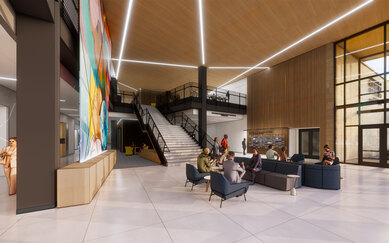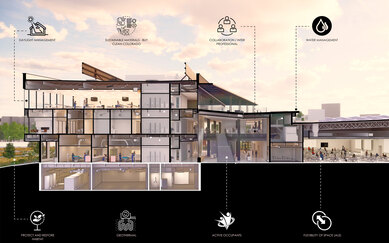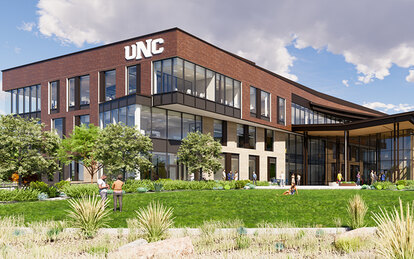University of Northern Colorado, College of Osteopathic Medicine
A College of Osteopathic Medicine marks a new era for UNC, ushering in its first postgraduate medical programs and elevating its status as a comprehensive academic institution.
Client
University of Northern Colorado
Location
Greeley, Colorado
Markets/Services
Academic Medicine, Architecture, Interiors, Health Education, Landscape Architecture, Lab Planning, Lighting Design, MEP Engineering, Fire Protection and Life Safety Engineering
Size
100,000 gsf
Founded in the 1880s as a teacher’s college, the University of Northern Colorado now offers more than 200 programs to a student body of 9,000. A public, doctoral research and educational institution, UNC is recognized as a top university for social mobility; nearly half of its students are the first in their family to attend post-secondary schooling. Building on the legacy of academic excellence and innovation, University leaders successfully lobbied the state to authorize a new medical school, a move that makes medical education more accessible and addresses the critical shortage of physicians across the state, particularly in rural communities.
UNC’s College of Osteopathic Medicine meets the milestone moment, a highly sustainable contemporary building that houses specialized laboratories, interactive learning spaces along with a supportive social infrastructure that nurture students engaged in an intensive field of study. The design integrates geothermal, photovoltaics, natural materials, abundant natural light and a naturalized landscape exemplifying its role as a place of health and wellbeing. Sited at the intersection of central and west campuses, it is a prominent symbol of UNC’s elevated academic stature.
The primary bar of the three-story building houses key program elements. It includes a standardized patient program area, simulation center and skills lab on the first level, faculty and administrative offices on the second level, and specialized learning spaces on the third level, including the osteopathic manipulative medicine lab, an anatomy lab and augmented reality studio. A southern wing is devoted to active learning environment classrooms, along with a demonstration kitchen that is part of the college’s holistic wellness curriculum.

Linking the two halves of the building, a central connector provides a large area for collaboration, study, relaxation and socialization. This key design element capitalizes on the building’s location and amplifies UNC’s priorities, creating a comfortable environment to relieve student stressors, support student success while offering opportunities for students representing diverse health professions to collaborate. The connector becomes a circulation hub within and through the building, leading to the Campus Commons to the east. Several other informal study and breakout spaces are distributed throughout the site, including a light-filled corner lounge, rooftop deck and a landscaped park that borders the broader community. Reflecting the university’s dedication to the whole health philosophy of osteopathy and the state’s Art in Public Places program, several works of art, including a feature wall mural by alumnus Armando Silva, are on permanent display throughout the site and facility. The integration of art reinforces the college’s emphasis on holistic wellness and healing.

Demonstrating UNC’s commitment to sustainability, the new building will achieve 34% energy savings over baseline. The high-performance building employs the university’s first geothermal field with 120 onsite geothermal wells drilled 500 feet deep to provide efficient heating and cooling. A large photovoltaic array atop the active learning environment wing offsets a third of the building’s energy use while bioswales manage stormwater naturally and effectively. From concept to daily operation, the College of Osteopathic Medicine is leading the University of Northern Colorado into an impactful new era with resounding benefits for Coloradans.
The new building design and construction was delivered by a Design/Build team including Adolfson & Peterson Construction, SmithGroup, and architectural partner, Dekker.
